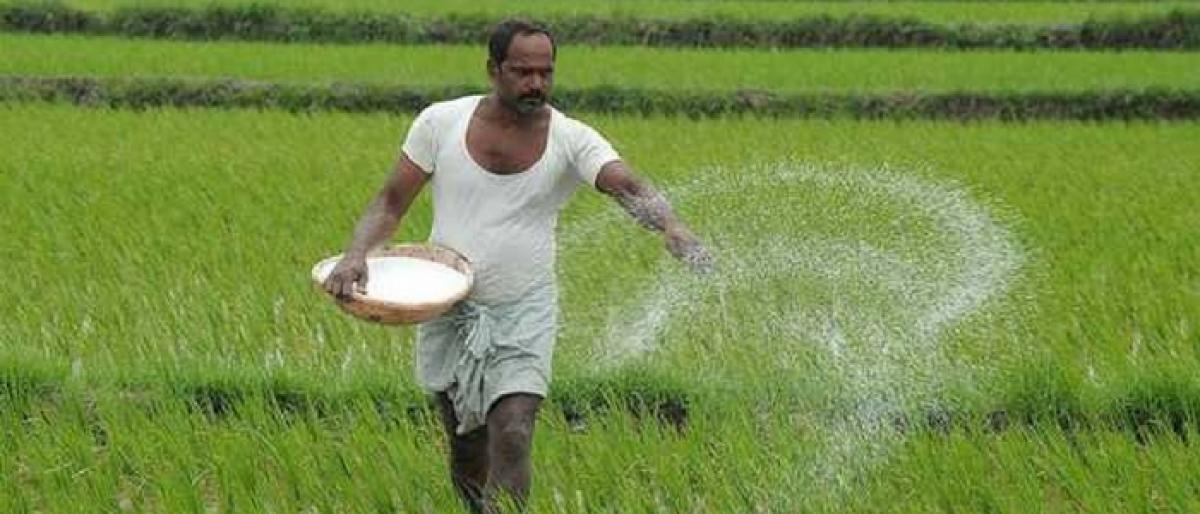Live
- Digital media platforms must curb fake news, safeguard democracy: Ashwini Vaishnaw
- BJP wants to form govt in Jharkhand to loot its natural resources: Kharge
- Germany's healthcare sector hit by skilled labour shortages
- Mallikarjun Kharge predicts INDIA bloc’s victory in Jharkhand, promises to fulfill seven guarantees
- Israel renews attacks on Beirut's southern suburbs after evacuation call
- Uzbekistan continues gas accounting, control to ensure stable supply
- Transform Anganwadi Centers into Hubs of Quality Nutrition and Education: Collector Badavath Santosh
- 'Never in history has Maharashtra slid so badly': Chidambaram faults BJP on state's economic condition
- Farmers Must Registered Livestock Details - Veterinary Doctors
- Rs 500 Bonus Per Quintal on Fine Paddy in Addition to MSP - Collector Badavath Santhosh
Just In

For the farmers who are already reeling under the impact of abysmally-low prices for their produce, the Goods & Services Tax (GST) that comes into play from July 1 portends more troubles with the tax burden on the fertilisers set to escalate by a significant six per cent.
Tax on fertilisers will double under new tax regime
Hyderabad: For the farmers who are already reeling under the impact of abysmally-low prices for their produce, the Goods & Services Tax (GST) that comes into play from July 1 portends more troubles with the tax burden on the fertilisers set to escalate by a significant six per cent.
Fertilisers and other farm nutrients are currently taxed at six per cent, but the GST Council headed by Union Finance Minister Arun Jaitley has placed them in 12 per cent tax bracket, thus paving way for the doubling of the taxes under the new indirect regime that was dubbed by many as a game changer for the Indian economy.
Farmers and leaders of farmers’ association termed the steep hike in the taxes on fertilisers as an anti-farmer move that would further destabilise the agriculture sector by increasing the production costs.
“With increase in taxes on fertilisers and other agriculture inputs, we estimate that the cultivation cost will go up by Rs 5,000 to Rs 6,000 per acre.
That’s a huge burden on the farmers who are already reeling under enormous financial stress due to low prices for their produce as evidenced in the violent protests across several states,” P Chengal Reddy, president, Consortium of Indian Farmers’ Association, told The Hans India.
Reddy pointed out about the 18 per cent GST on pesticides and five per cent on tractors which, he said, would be detrimental to the interests of farmers. “Fertilisers are heavily used for paddy, chilli and cotton crops across Andhra Pradesh and Telangana.
Lakhs of farmers in both the states will have to bear the extra tax burden as fertiliser makers and dealers will have no option except passing it on to them,” he said.
Industry insiders estimate that there will be additional burden of Rs 1,000 crore on account of extra tax on urea alone and the amount will increase multifold if all other fertiliser products are included. It is unlikely that the central government will increase subsidy on fertilisers to foot the increased tax.
“Farmers’ condition is pathetic, to say the least. We lose heavily when weather gods work against us, but that’s understandable.
But we have lost everything this year even after we had bumper crops of paddy, chilli and pulses. Then when will farmers benefit and get remunerative returns for their hard work?” asks Kankanala Raji Reddy, a farmer from Mahadevpur in Bhupalpally district of Telangana.
Ruing the anti-farmer decision of the central and state governments to impose 12 per cent tax on fertilisers under the GST, Reddy observed that this additional tax burden would further ruin the lives of farmers as it would escalate the cost.
According to him, 75 kgs of diammonium phosphate (DAP) or two bags are used for every acre of paddy cultivated. In addition, 150 kg urea (3 bags) and 50 kg of muriate of potash (one bag) are required.
The usage of these fertilisers and others are much more for the cultivation of chillis and cotton. In the case of chillis, farmers will have to use 12-15 bags of urea and two bags of DAP per acre while cotton crops require five and two bags respectively. A 50-kg DAP bag is priced over Rs 1,200 while the heavily-subsidised urea costs Rs 276 per bag.
Chengal Reddy said farmers’ bodies were in the process of coming together at national level for solving problems and challenges being faced by the farmers through agitations. “There is unrest among farming community across the country as farmers are not able to get remunerative prices.
There are also the issues of loan waiver and the implementation of Swaminathan Commission report,” he said.

© 2024 Hyderabad Media House Limited/The Hans India. All rights reserved. Powered by hocalwire.com







